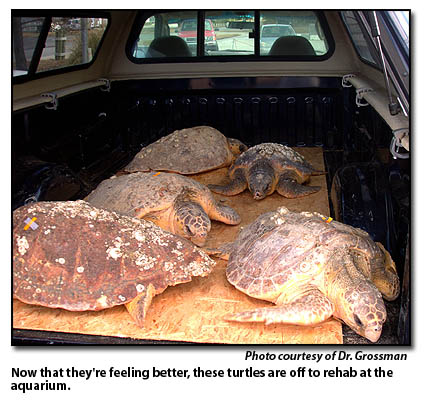By SUNDAE HORN
By SUNDAE HORN
On Saturday, Feb. 6, during a nasty coastal storm, National Park Service personnel found 19 live stranded sea turtles on Ocracoke beaches and carried them to safety.
“We had strong winds Friday night, and the high tides were up to the dunes,” said NPS biotechnician Jocelyn Wright. “The next day, we found the turtles. They were all over the beach from South Point to the north end of the island.”
The stranded sea turtles were “cold-stunned,” a condition that they suffer when there’s a sudden drop in water temperatures. They go into shock and are comatose. Cold-stunned turtles drift along the current and wash ashore, eventually suffering organ failure and, more often than not, death.
Stranded sea turtles are not uncommon on the Outer Banks in the winter months. In fact, Cape Hatteras National Seashore biotechnicians had already counted almost 300 strandings since Dec. 1.
But on Feb. 6, just when the biotechs thought the stranding season should be slowing down, they were surprised by a mass stranding event. Even more surprising was that most of the turtles were still alive when the park rangers found them.
“We worked all day to save them,” said Wright. “It was a joint effort. [Law enforcement rangers] Ed Fuller and Bill Caswell were great, the volunteers were a great help. It took a lot of people and trucks to get the turtles all off the island.”
Wright and her crew rescued 16 loggerheads, two Kemp’s ridleys, and one green turtle. The turtles were trucked up the beach to their first stop at Roanoke Island Animal Clinic, and then to aquariums around the state for rehabilitation. Eventually, these turtles will be returned to the Gulf Stream.
Wright, who’s been working for Cape Hatteras National Seashore on Ocracoke for two years, recently accepted a permanent job as Ocracoke’s year-round biotech. She was ecstatic after her day of turtle-rescuing.
“All of them are still alive and doing well,” she said happily.
Michelle Bogardus is the Seashore’s turtle expert. She says that since Feb. 6, NPS had learned that Ocracoke’s 19 sea turtles were part of a huge mass stranding that stretched farther south.
About 100 turtles died on Portsmouth Island that day.
“No one could get to Portsmouth until Sunday,” she said.
By then it was too late.
On Sunday afternoon, Ocracoker and NPS volunteer Chris Hadley kayaked over to Portsmouth to see the damage and found one live turtle – a small Kemp’s ridley. He brought it back to Ocracoke on his kayak, and it ended up at Roanoke Island Animal Clinic. It was the only survivor from Portsmouth, but sadly it, too, died after arriving at the clinic.
“It had just been out there too long,” Bogardus said.
“The Kemp’s ridley is the most endangered turtle in the world, and losing one is always tough,” said Bogardus. “But it’s not unusual to see them cold-stunned.”
What did surprise her about the mass stranding was that so many – more than 90 percent – of the turtles were juvenile loggerheads. Although loggerheads are the most abundant species of sea turtle on the Outer Banks, most of the winter cold-stunned victims are young football-sized green turtles. But most strandings occur on the soundside or along inlets. This last event, said Bogardus, was primarily on the oceanside, another aspect that made it remarkable.
“It was an anomaly to see so many loggerheads, and these were all too small to breed, about 150 pounds at the most, while full-size breeding adults weigh about 300 pounds,” she said.
“Theoretically, these turtles should swim south in the late fall and winter when the water cools,” Bogardus said, adding that the Outer Banks can see strandings as early as November.
The turtles who stay up north hang out offshore in the warmer waters of the Gulf Stream current, unless high winds blow them into colder water. It’s not necessarily just the cold that stuns them, but the sudden drop in temperatures that their system can’t handle. And migrating south is no guarantee of good health – the unusually cold winter in Florida this year has caused 5,000 cold-stunned strandings.
“We’re having a lot of turtles get stranded right now,” Bogardus said. “And most of them recently have been dead. We were lucky enough to keep these 19 from Ocracoke alive.”
Four years ago, Cape Hatteras National Seashore reported 20 cold-stunned sea turtles. This year, there have been nearly 300, and there were almost that many last year. But the increase isn’t necessarily because more turtles are getting stranded than before, said Bogardus.
“There wasn’t a year-round biotech position here until three years ago,” she said. “So we have to ask ‘How many more are we finding because we are looking for them?’ The locals have seen the strandings for years, but never documented the numbers. Now, we’re looking for them, and counting every one.”
As for the Ocracoke turtles – all still alive and well – what happens next?
After being warmed up at Roanoke Island Animal Clinic, the turtles were farmed out to aquariums willing to take them.
“They go wherever there’s room,” Bogardus said. “Everyone was full, but they took in two or three more anyway.”
Three loggerheads, two Kemp’s ridleys and one green stayed at the North Carolina Aquarium on Roanoke Island. Some will go to the Pine Knoll Shores Aquarium, some to aquariums in Georgia and South Carolina. The turtles will recover from their trauma and then go home.
“The aquariums and Park Service and the state all coordinate with the U.S. Coast Guard,” said Wright. “The Coast Guard takes them out and puts them back in the Gulf Stream.”
Subject
Name
(required, will not be published)
(required, will not be published)
City :
State :
Your Comments:
May be posted on the Letters to the Editor page at the discretion of the editor.
May be posted on the Letters to the Editor page at the discretion of the editor.
May be posted on the Letters to the Editor page at the discretion of the editor.
May be posted on the Letters to the Editor page at the discretion of the editor.









